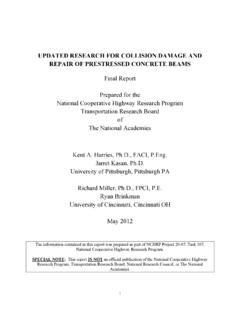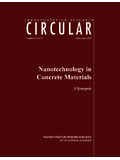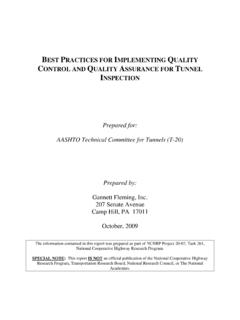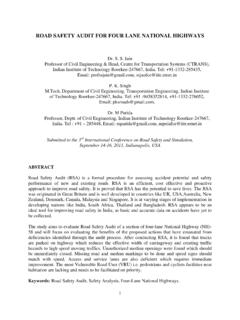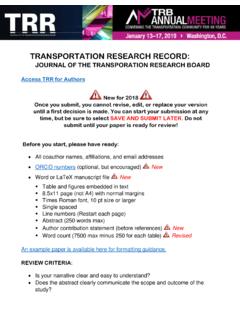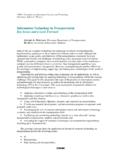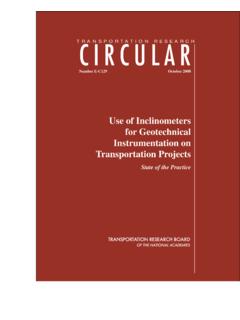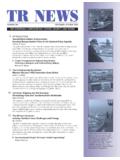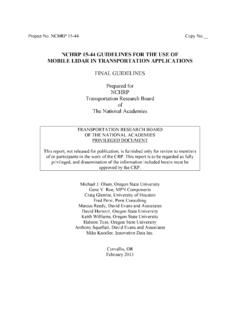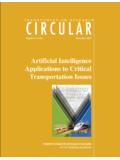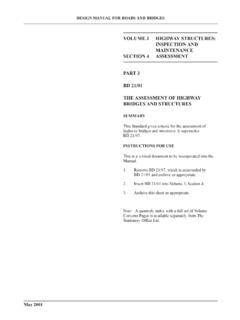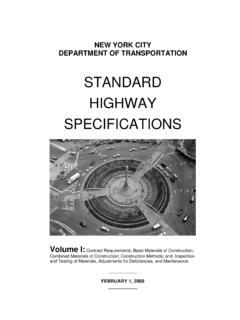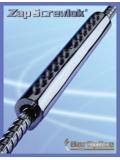Transcription of NCHRP Project 20-68A Scan 09-05 Best Practices For Roadway ...
1 NCHRP Project 20-68A . Scan 09-05 . Best Practices For Roadway tunnel design , construction , maintenance , inspection , And operations Supported by the National Cooperative Highway Research Program April 2011. The information contained in this report was prepared as part of NCHRP Project 20 68A Domestic Scan, National Cooperative Highway Research Program. SPECIAL NOTE: This report IS NOT an official publication of the National Cooperative Highway Research Program, Transportation Research Board, National Research Council, or The National Academies. Acknowledgments The work described in this document was conducted as part of NCHRP Project 20-68A , the Domestic Scan program. This program was requested by the American Association of State Highway and Transportation Officials (AASHTO), with funding provided through the National Cooperative Highway Research Program ( NCHRP ).
2 The NCHRP is supported by annual voluntary contributions from the state departments of transportation. Additional support for selected scans is provided by the Federal Highway Administration and other agencies. The purpose of each scan and of Project 20-68A as a whole is to accelerate beneficial innovation by facilitating information sharing and technology exchange among the states and other transportation agencies, and identifying actionable items of common interest. Experience has shown that personal contact with new ideas and their application is a particularly valuable means for such sharing and exchange. A scan entails peer-to-peer discussions between practitioners who have implemented new Practices and others who are able to disseminate knowledge of these new Practices and their possible benefits to a broad audience of other users.
3 Each scan addresses a single technical topic selected by AASHTO and the NCHRP 20-68A Project Panel. Further information on the NCHRP 20-68A Domestic Scan program is available at This report was prepared by the scan team for Scan 09 05, Best Practices for Roadway tunnel design , construction , maintenance , inspection , and operations , whose members are listed below. Scan planning and logistics are managed by Arora and Associates, ; Harry Capers is the Principal Investigator. NCHRP Project 20 68A is guided by a technical Project panel and managed by Andrew C. Lemer, , NCHRP Senior Program Officer. Kevin Thompson, , Caltrans, AASHTO Co-Chair Jesus Rohena, , FHWA, FHWA Co-Chair Alexander K. Bardow, , Massachusetts DOT. Barry B. Brecto, , FHWA Washington State Division Bijan Khaleghi, , , , Washington State DOT.
4 Louis Ruzzi, , Pennsylvania DOT. Michael G. Salamon, Colorado DOT. Fulvio Tonon, , , Liaison, TRB Tunnels and Underground Structures Committee Mary Lou Ralls, , Report Facilitator B E ST P R AC T I C E S F O R R OA DWAY T U N N E L D E S I G N , CO N ST R U C T I O N , M A I N T E N A N C E , I N S P E C T I O N , A N D O P E R AT I O N S. Disclaimer The information in this document was taken directly from the submission of the authors. The opinions and conclusions expressed or implied are those of the scan team and are not necessarily those of the Transportation Research Board, the National Research Council, or the program sponsors. This document has not been edited by the Transportation Research Board. Scan 09-05 . Best Practices For Roadway tunnel design , construction , maintenance , inspection , And operations REQUESTED BY THE.
5 American Association of State Highway and Transportation Officials P R E PA R E D B Y. Kevin Thompson, , Louis Ruzzi, , Caltrans, AASHTO Co Chair Pennsylvania DOT. Jesus Rohena, , Michael G. Salamon, FHWA, FHWA Co Chair Colorado DOT. Alexander K. Bardow, , Fulvio Tonon, , , Massachusetts DOT Liaison, TRB Tunnels and Underground Structures Committee Barry B. Brecto, , FHWA Washington State Division Mary Lou Ralls, , Report Facilitator Bijan Khaleghi, , , , Washington State DOT. S C A N M A N AG E M E N T. Arora and Associates, Lawrenceville, NJ. April 2011. The information contained in this report was prepared as part of NCHRP Project 20 68A Domestic Scan, National Cooperative Highway Research Program. SPECIAL NOTE: This report IS NOT an official publication of the National Cooperative Highway Research Program, Transportation Research Board, National Research Council, or The National Academies.
6 B E ST P R AC T I C E S F O R R OA DWAY T U N N E L D E S I G N , CO N ST R U C T I O N , M A I N T E N A N C E , I N S P E C T I O N , A N D O P E R AT I O N S. 6. Table of Contents Abbreviations and VII. Executive ES-1..ES-1. Scan Purpose and Scope .. ES-1. Summary of Findings and Recommendations .. ES-2. 1) Develop standards, guidance, and best Practices for Roadway ES-2. 2) Develop an emergency response system plan unique to each facility which takes into account human behavior, facility ventilation, and fire ES-3. 3) Develop and share inspection Practices among tunnel ES-4. 4) Consider inspection and maintenance operations during the design 5) Develop site-specific plans for the safe and efficient operation of Roadway 6) A tunnel includes a long-term commitment to provide funding for preventive maintenance , upgrading of systems, and training and retention of 7) Share existing technical knowledge within the industry to design a ES-7.
7 8) Provide education and training in tunnel design and ES-7. Planned Implementation ES-7. 1-1. Scan Host 1-2. Alaska Department of Transportation and Public Facilities (AKDOT&PF).. 1-3. California Department of Transportation (Caltrans).. 1-3. Colorado Department of Transportation (CDOT).. 1-4. District of Columbia Department of Transportation (DDOT).. 1-5. Massachusetts Department of Transportation (MassDOT).. 1-6. Pennsylvania Department of Transportation (PennDOT).. 1-6. Port Authority of New York and New Jersey (PANY&NJ).. 1-7. Virginia's Chesapeake Bay Bridge and tunnel District (CBBT District).. 1-7. Virginia Department of Transportation (VDOT).. 1-8. Washington State Department of Transportation (WSDOT).. 1-9. City of Seattle (Seattle DOT and Seattle Fire Department).
8 1-10. Sound 1-10. Scan Team .. 1-11. B E ST P R AC T I C E S F O R R OA DWAY T U N N E L D E S I G N , CO N ST R U C T I O N , M A I N T E N A N C E , I N S P E C T I O N , A N D O P E R AT I O N S. I. TA B L E O F C O N T E N T S. Findings and . 2-1. US tunnel 2-1. Number of Tunnels in 2-2. Ages of Tunnels .. 2-2. tunnel Definition .. 2-3. Current Definitions Used by . 2-3. Proposed Changes to AASHTO tunnel . 2-4. Differentiation between Wide Bridges over Highways and Short 2-6. Inventory Numbering 2-6. Inventory of Geometric Characteristics Relative to 2-7. Referencing 2-8. Inventory of Changes in tunnel Cross . 2-8. Inventory of tunnel Approaches .. 2-9. Standards, Guidance, and Best Practices for Existing and New Roadway 2-9. 2-9. Rationale for Choosing Parameters for tunnel .
9 2-12. Clearance Envelope Requirements for 2-14. Seismic design Correlation of Seismic Strains to Liner Collapse Mechanism and to Acceptable Damage and Leakage .2-17. Seismic and Other Criteria for Portals and Approach 2-18. tunnel Life . 2-19. Poor maintenance Considerations in . 2-21. Recent Best Practice construction 2-23. tunnel Boring Machine Manufacturer Support and 2-24. maintenance , Repair, and Rehabilitation .. 2-25. maintenance Issues Related to 2-25. maintenance Effectiveness in Decreasing Age-Related Definition of Good Repair and Process for Deferral of 2-29. Most Significant tunnel maintenance 2-31. Concrete-Lined tunnel Repair and 2-32. Ventilation 2-33. maintenance of Devices in tunnel Environment with tunnel 2-34. Frequency of tunnel 2-35. II. maintenance 2-37.
10 Mechanism to Maintain, Debug, and Troubleshoot 2-38 Timing of maintenance 2-48. Capacity of maintenance Yard 2-40. Current Best Practices .. 2-40. inspection Frequency of Systems and System 2-42. inspection Documentation and 2-43. inspection Program 2-44. tunnel Segments for inspection and 2-45. Procedures to Inspect Rock Tunnels with No 2-46. Timing of 2-46. 2-47. Integration of Operation Controls for Traffic and Support 2-47. Measures to Reduce Operating Trials of Emergency Response Procedures to Keep Records on Fire 2-53. Mechanisms Deployed for Fire Safety and Minimized Procedure for Communicating with Local Emergency 2-56. Systems and Protocols for Emergency Information to 2-57. 2-59. Recommended Changes to 2009 FHWA Technical Manual for design and construction of Road Tunnels Civil Use of a tunnel Management System to Track Condition, inspection , Repair, and Needed 2-59.
